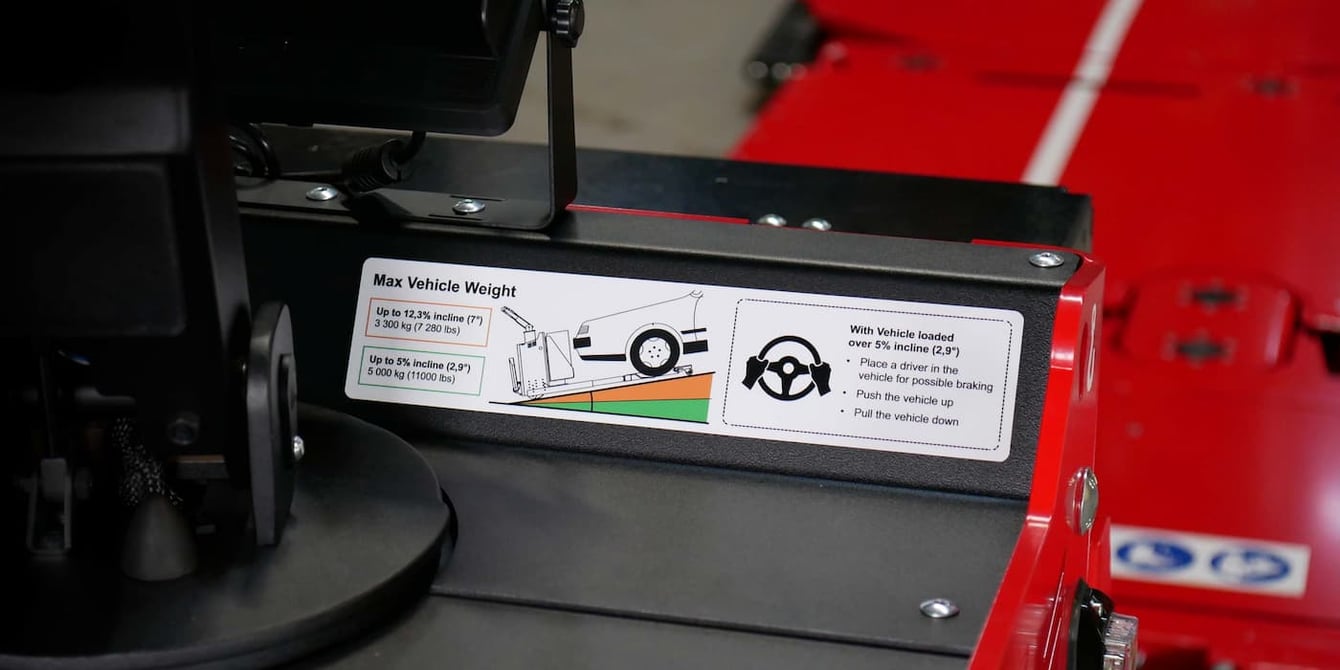The demand for solutions that let you move vehicles on sloping surfaces is on the rise across the automotive industry. But as the gradient increases, so does the risk. Here’s an industry expert’s view on the limitations and possibilities of getting cars up and down ramps in a safe and controlled manner.
But before we talk about best practices and suitable equipment for this challenging task—what’s behind the increased demand? Magnus Grafström, CTO of Stringo, has extensive experience in developing safe vehicle moving solutions for the automotive industry. He sees three main drivers behind the trend:
1. New manufacturers converting old facilities
“With the shift toward EVs, we’ve seen new players enter the automotive industry, particularly in the US. Building production facilities from scratch is both expensive and time-consuming. Instead, these companies tend to buy up existing properties and convert them into factories, service centers, and delivery centers. The buildings often have loading docks with ramps to get goods in and out. This isn’t ideal for moving cars, but it’s a reality that these up-and-coming businesses have needed to adapt to.”
2. Businesses adapting to the risk of flooding
“As a result of climate change, automotive manufacturers in Asia have started taking the risk of flooding into account by building new facilities higher above ground level. So for a different reason than the example above, these companies are also relying on ramps to get their cars in and out.”
3. Improved safety standards in car dealerships and other sectors
“Traditionally, safe and efficient vehicle moving has mainly been a priority for automotive manufacturers that need to get non-starters from the end-of-line quickly. But work environment standards are being raised in other areas as well. Car dealerships are a good example. Larger companies in this field often operate across several floors, connected by ramps. There is an increased demand for safe alternatives to driving the car up and down these sloping surfaces.”
Key parameters when moving vehicles on sloping surfaces
Moving a car up or down a sloping surface in a controlled manner, with your braking capability intact, requires a strong combination of pulling power and grip. Below, Grafström explains the five main factors to take into account when assessing and averting safety risks:
1. Gradient
“At Stringo, we treat any gradient over 5% as a special order project that requires customisations. With the right parameters and equipment in place, it’s possible to move cars up and down slopes with a gradient of up to 14%.”
2. Vehicle weight
“On a flat surface, our toughest vehicle movers can handle cars weighing up to 5 metric tons. But with a gradient of 5% or more, that would be too risky. The maximum vehicle weight you can safely move up and down ramps, if the conditions are right, is 3,3 metric tons.”
3. Surface quality
“To ensure sufficient grip, the surface needs to be made of high-quality material, such as concrete, asphalt, or steel. It also needs to be clean, dry, and free of any obstructions.”
4. Ramp properties
“Is the ramp crest sharp or rounded? The angle is important for determining the optimal height of the vehicle mover. You always want your mover to be as low as possible to allow maximum flexibility in the cars you can use it for, but if the ground clearance is too low, the vehicle mover can get stuck on the crest.”
5. On-site operations
“The vehicle needs to be slowly pushed up and pulled down, with the vehicle mover always placed below the car in the slope. The machine operator needs to be properly trained for the task. As an extra safety measure, a person should also sit in the car while it’s being moved and be prepared to brake if needed.”
Vehicle movers that develop with the changing demands
To meet the increased demand for vehicle moving on sloping surfaces, the Stringo team works closely with customers to develop safe and efficient solutions.
“We analyse the necessary data and simulate the process in CAD to ensure there’s enough ground clearance at the ramp crest. We also visit the client on-site to get a full understanding of their vehicles and environment, validate the end result and provide operator training,” Magnus explains.
In fact, the Stringo high-performance module was originally developed to solve a challenging situation for an EV manufacturer:
“We fitted one of our existing models, the Stringo 550, with a more powerful engine to add pulling strength and significantly larger drive wheels to increase the friction against the underlying surface. This enabled the client to move 3,2 metric ton cars up and down a 14% gradient in a safe and controlled manner. And as is often the case at Stringo, a solution we originally created to fit a specific customer has proven useful to many others with similar challenges,” Grafström concludes.
Do you need to move cars safely in a challenging environment? Download our e-book to learn more about the options available:






